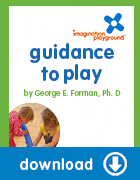Children are creative and go beyond treating the blocks as physical elements for building and climbing.
They also treat the blocks as props with symbolic status. They may place a gear on top of their head as if it were a crown or bend a noodle into a loop to wear like a huge belt with the Little Cheese as the buckle.

This boy holds noodle and wields it like a sword, using a Clover Gear as a shield to his hand. Often five or six boys will create these swords using noodles or cylinders to have mock fencing matches.

This boy made a barbell with two Little Cheeses and a noodle. He likes the way the noodle bends when he lifts the barbell, as if it shows the heaviness of his pretend weights.
What It Means
Once a prop is endowed with a role in pretend play, the prop gives continuity to the play by bridging segments of the action. If the magic belt makes its wearer invisible, it helps others know who is invisible now. The prop provides some limits on what the pretend actions mean and thereby structures the script.
2-4 Year Olds
Consider the difference between a prop you wear or hoist versus an object you carry. A young child may carry a Plug around because it satisfies a sense of “having” the object, but she may not relate the object to their body in any special way. Even so, this desire to “have” a particular object is the first step toward pretend play as the children make up action routines with that object.
4-7 Year Olds
Older children will make simple props with defining details (magic wand with handle).
7-10 Year Olds
Still older children more complicated props (barbell with bench and rack). The physical complexity of the prop parallels the creation of more complex themes, such as scripts with action segments that use multiple props and players.
This material is adapted from the publication “Imagination Playground’s Guidance to Play” by George E. Forman, PhD, Emeritus Professor, University of Massachusetts (Amherst) and President of Videatives, Inc.
Dr. Forman has over 33 years of experience in university teaching, cognitive research, multimedia design and educational consulting in the area of early childhood learning and development.
“Guidance to Play” covers 20 topics that help illustrate the significance in what children are doing as they play as well as concrete actions Play Associates can take to facilitate positive behaviors.



